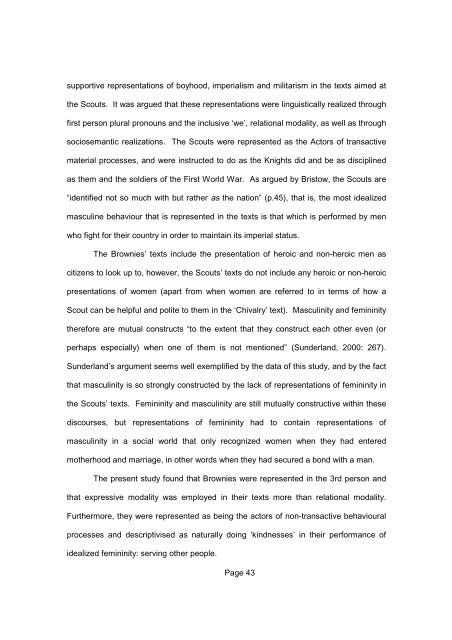A Discussion of the Representation of Masculinity and Femininity in ...
A Discussion of the Representation of Masculinity and Femininity in ...
A Discussion of the Representation of Masculinity and Femininity in ...
Create successful ePaper yourself
Turn your PDF publications into a flip-book with our unique Google optimized e-Paper software.
supportive representations <strong>of</strong> boyhood, imperialism <strong>and</strong> militarism <strong>in</strong> <strong>the</strong> texts aimed at<br />
<strong>the</strong> Scouts. It was argued that <strong>the</strong>se representations were l<strong>in</strong>guistically realized through<br />
first person plural pronouns <strong>and</strong> <strong>the</strong> <strong>in</strong>clusive ‘we’, relational modality, as well as through<br />
sociosemantic realizations. The Scouts were represented as <strong>the</strong> Actors <strong>of</strong> transactive<br />
material processes, <strong>and</strong> were <strong>in</strong>structed to do as <strong>the</strong> Knights did <strong>and</strong> be as discipl<strong>in</strong>ed<br />
as <strong>the</strong>m <strong>and</strong> <strong>the</strong> soldiers <strong>of</strong> <strong>the</strong> First World War. As argued by Bristow, <strong>the</strong> Scouts are<br />
“identified not so much with but ra<strong>the</strong>r as <strong>the</strong> nation” (p.45), that is, <strong>the</strong> most idealized<br />
mascul<strong>in</strong>e behaviour that is represented <strong>in</strong> <strong>the</strong> texts is that which is performed by men<br />
who fight for <strong>the</strong>ir country <strong>in</strong> order to ma<strong>in</strong>ta<strong>in</strong> its imperial status.<br />
The Brownies’ texts <strong>in</strong>clude <strong>the</strong> presentation <strong>of</strong> heroic <strong>and</strong> non-heroic men as<br />
citizens to look up to, however, <strong>the</strong> Scouts’ texts do not <strong>in</strong>clude any heroic or non-heroic<br />
presentations <strong>of</strong> women (apart from when women are referred to <strong>in</strong> terms <strong>of</strong> how a<br />
Scout can be helpful <strong>and</strong> polite to <strong>the</strong>m <strong>in</strong> <strong>the</strong> ‘Chivalry’ text). <strong>Mascul<strong>in</strong>ity</strong> <strong>and</strong> fem<strong>in</strong><strong>in</strong>ity<br />
<strong>the</strong>refore are mutual constructs “to <strong>the</strong> extent that <strong>the</strong>y construct each o<strong>the</strong>r even (or<br />
perhaps especially) when one <strong>of</strong> <strong>the</strong>m is not mentioned” (Sunderl<strong>and</strong>, 2000: 267).<br />
Sunderl<strong>and</strong>’s argument seems well exemplified by <strong>the</strong> data <strong>of</strong> this study, <strong>and</strong> by <strong>the</strong> fact<br />
that mascul<strong>in</strong>ity is so strongly constructed by <strong>the</strong> lack <strong>of</strong> representations <strong>of</strong> fem<strong>in</strong><strong>in</strong>ity <strong>in</strong><br />
<strong>the</strong> Scouts’ texts. <strong>Fem<strong>in</strong><strong>in</strong>ity</strong> <strong>and</strong> mascul<strong>in</strong>ity are still mutually constructive with<strong>in</strong> <strong>the</strong>se<br />
discourses, but representations <strong>of</strong> fem<strong>in</strong><strong>in</strong>ity had to conta<strong>in</strong> representations <strong>of</strong><br />
mascul<strong>in</strong>ity <strong>in</strong> a social world that only recognized women when <strong>the</strong>y had entered<br />
mo<strong>the</strong>rhood <strong>and</strong> marriage, <strong>in</strong> o<strong>the</strong>r words when <strong>the</strong>y had secured a bond with a man.<br />
The present study found that Brownies were represented <strong>in</strong> <strong>the</strong> 3rd person <strong>and</strong><br />
that expressive modality was employed <strong>in</strong> <strong>the</strong>ir texts more than relational modality.<br />
Fur<strong>the</strong>rmore, <strong>the</strong>y were represented as be<strong>in</strong>g <strong>the</strong> actors <strong>of</strong> non-transactive behavioural<br />
processes <strong>and</strong> descriptivised as naturally do<strong>in</strong>g ‘k<strong>in</strong>dnesses’ <strong>in</strong> <strong>the</strong>ir performance <strong>of</strong><br />
idealized fem<strong>in</strong><strong>in</strong>ity: serv<strong>in</strong>g o<strong>the</strong>r people.<br />
Page 43

















